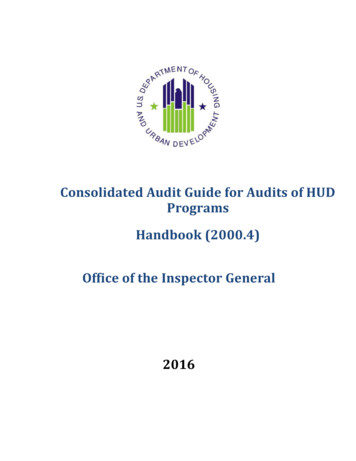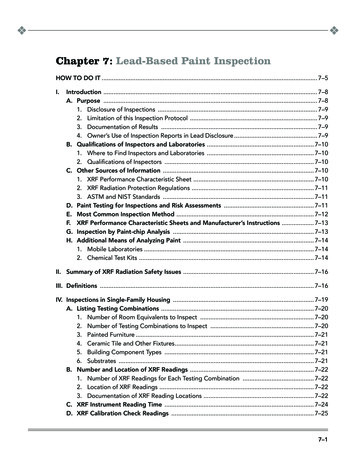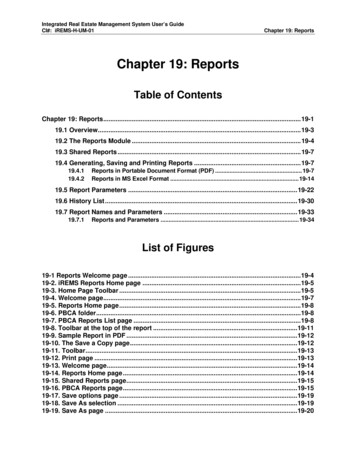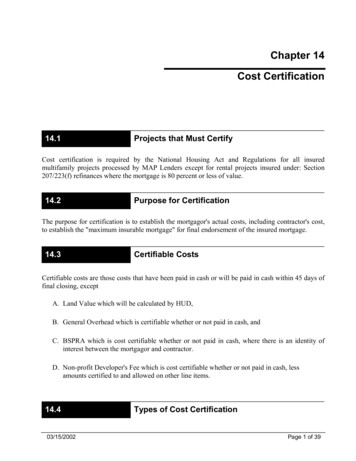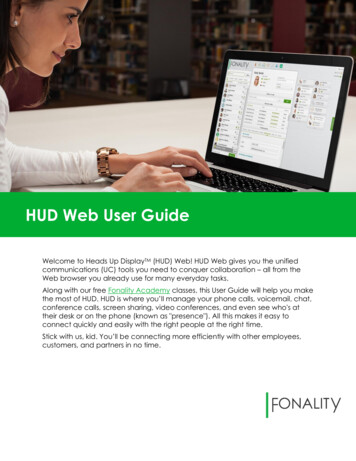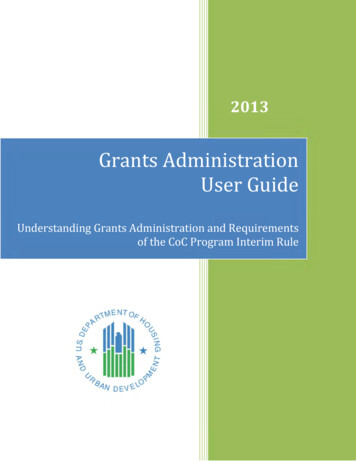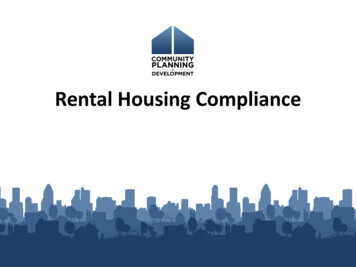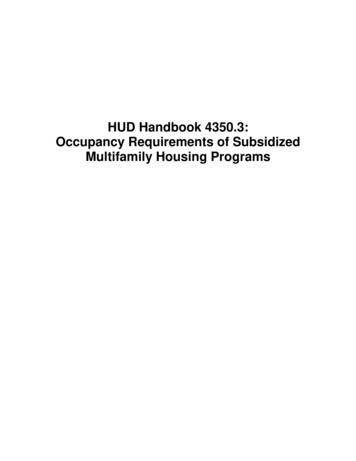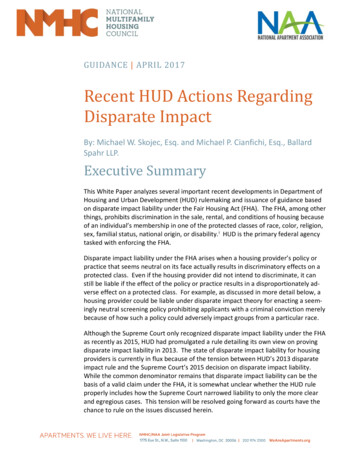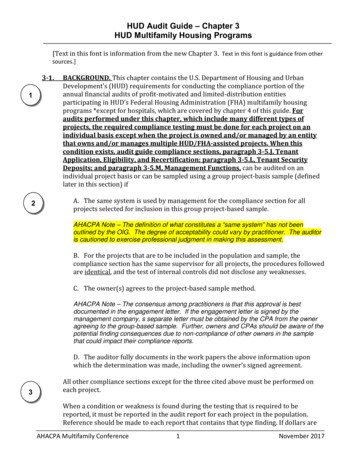
Transcription
HUD Audit Guide – Chapter 3HUD Multifamily Housing Programs[Text in this font is information from the new Chapter 3. Text in this font is guidance from othersources.]3‐1.12BACKGROUND. This chapter contains the U.S. Department of Housing and UrbanDevelopment’s (HUD) requirements for conducting the compliance portion of theannual financial audits of profit‐motivated and limited‐distribution entitiesparticipating in HUD’s Federal Housing Administration (FHA) multifamily housingprograms *except for hospitals, which are covered by chapter 4 of this guide. Foraudits performed under this chapter, which include many different types ofprojects, the required compliance testing must be done for each project on anindividual basis except when the project is owned and/or managed by an entitythat owns and/or manages multiple HUD/FHA‐assisted projects. When thiscondition exists, audit guide compliance sections, paragraph 3‐5.J, TenantApplication, Eligibility, and Recertification; paragraph 3‐5.L, Tenant SecurityDeposits; and paragraph 3‐5.M, Management Functions, can be audited on anindividual project basis or can be sampled using a group project‐basis sample (definedlater in this section) ifA. The same system is used by management for the compliance section for allprojects selected for inclusion in this group project‐based sample.AHACPA Note – The definition of what constitutes a “same system” has not beenoutlined by the OIG. The degree of acceptability could vary by practitioner. The auditoris cautioned to exercise professional judgment in making this assessment.B. For the projects that are to be included in the population and sample, thecompliance section has the same supervisor for all projects, the procedures followedare identical, and the test of internal controls did not disclose any weaknesses.C. The owner(s) agrees to the project‐based sample method.AHACPA Note – The consensus among practitioners is that this approval is bestdocumented in the engagement letter. If the engagement letter is signed by themanagement company, s separate letter must be obtained by the CPA from the owneragreeing to the group-based sample. Further, owners and CPAs should be aware of thepotential finding consequences due to non-compliance of other owners in the samplethat could impact their compliance reports.D. The auditor fully documents in the work papers the above information uponwhich the determination was made, including the owner’s signed agreement.3All other compliance sections except for the three cited above must be performed oneach project.When a condition or weakness is found during the testing that is required to bereported, it must be reported in the audit report for each project in the population.Reference should be made to each report that contains that type finding. If dollars areAHACPA Multifamily Conference1November 2017
HUD Audit Guide – Chapter 3HUD Multifamily Housing Programsinvolved, only the dollars belonging to that specific project should be included in thatproject’s audit finding. For example, significant deficiencies found or findings developedmust be included in the audit report for all projects that were grouped for the groupproject‐based population. The following illustrates wording that can be used. “Thisinternal control problem applies to and is reported in 15 audit reports, 5 for projectsowned by companies related to the X Housing Cooperation and 10 projects owned by twounrelated owners. The total disallowed cost is 450,000, of which 100,000 applies to thisproject, and 200,000 applies to the other 4 projects owned by companies related to the XHousing Cooperation and 150,000 applies to the 10 projects owned by the two unrelatedowners.” Additionally, nonmaterial instances of noncompliance must be reported in amanagement letter or other written correspondence for each project in the population(reporting requirements are included in paragraph 3‐8 of this chapter).AHACPA Note – In accordance with the guidance contained in the transmittal letter tothe Guide, management letters are now to be provided to HUD in the REAC submission.This process will be discussed in paragraph 3-8 following.Also, auditors will be able to convey nonmaterial instances of noncompliance tomanagement via a management letter or other type of auditor‐writtencommunication as long as the requirements of chapter 2, paragraph F, are followed.Chapter 2 requirements provide that the existence of a management letter or othertype of auditor communication must be mentioned in the independent auditor’sreport, the date of issuance is to be included, and those letters/communicationsmust be provided to HUD with the audit report package.4A group project‐based sample must include at least 20 percent of the projects with noless than a minimum of four projects to be reviewed each year for compliance withaudit steps contained in sections 3‐5J, 3‐5L, and 3‐5M. This will result in each project inthe population being reviewed at least every five years or less for those compliancesections. The following examples illustrate this point:Example 1. An auditor has 50 projects in the population that are to be audited, andthe conditions permit the auditor to use group project‐based sampling. The auditorwould test 20 percent or 10 projects since this amount is greater than four.Example 2. An auditor has 10 projects in the population that are to be audited, andthe conditions permit the auditor to use group project‐based sampling. The auditorwould test the minimum of four projects since 20 percent would only be twoprojects.AHACPA Note – The provision to require at least 20% of the projects in the sampleshould not be interpreted as a mandate to sample in this fashion or to preclude samplescontaining the entire population. This provision simply sets a minimum percentage ofprojects to be included if the auditor elects to sample in this manner. As a result of theabove provision, each project should be included in a sample at least once every 5years. Therefore, if a randomly selected sample of the entire population of projects didAHACPA Multifamily Conference2November 2017
HUD Audit Guide – Chapter 3HUD Multifamily Housing Programsnot result in every project being sampled within the 5-year period, that project wouldhave to be included in the sample in the fifth year.Specific projects from the population may be added to the sample based on a riskanalysis or for any other reason. However, any specific project shall not be counted as apart of the 20 percent or minimum sample of four for that year.5AHACPA Note – Samples may be stratified. If the auditor knows that certain projectshave specific, known weaknesses in internal control or with compliance, the auditorcould elect to test these projects on a stand-alone basis and not include them in thegroup project sample. However, as noted above, projects so removed cannot qualify forthe 20% minimum testing requirement.If the auditor elects to use the project‐based sampling method, the sampling scheduleand system for selecting must be included in the work papers so auditors can laterensure that all projects in the population will continue to be audited systematically.AHACPA Note –Obviously, this requirement places an additional documentationrequirement on the CPA. Workpaper documentation must include sufficient detail todocument the 5-year sampling requirement.The auditor’s opinion on compliance is to be provided for each individual project, andthe compliance testing must support the opinion for each individual project and not thegroup as a whole.Practitioners with nonprofit projects as clients, who participate in HUD/FHAmultifamily housing programs covered by the Single Audit Act, are to conduct audits inaccordance with Office of Management and Budget (OMB) Circular A‐133, Audits ofStates, Local Governments and Non‐Profit Organizations, and with the requirementscontained in OMB Circular A‐133’s, Compliance Supplement, which can be found on theOMB Web sitehttp://www.whitehouse.gov/omb/grants/grants circulars.htmlThis chapter is not intended to be a program‐specific audit guide for compliance withthe A‐133 requirements. If the Compliance Supplement includes the program that isbeing audited, the guidance in the supplement is to be used. If the ComplianceSupplement does not include the program that is being audited, part 7 of thesupplement provides guidance on how to identify the applicable compliancerequirements to test. Paragraph 1d of part 7 states “If there is an audit guidance issuedby the Federal agency’s Office of Inspector General (OIG), the auditor may wish toconsider this guidance in identifying the program objectives, program procedures, andcompliance requirements.” This guide should be used only for that purpose.3‐2.REFERENCE MATERIAL. The following is the reference material that was in effect atthe time this audit guide was issued. It is the auditor’s responsibility to use theprocedures that were in effect during the period covered by the audit.AHACPA Multifamily Conference3November 2017
HUD Audit Guide – Chapter 3HUD Multifamily Housing ProgramsThe audit procedures that are established in this guide are based on the proceduresthat were in effect when the guide was written. The auditor must determine theprocedures that were in effect during the audit period which their client was to follow.The auditor must conform those procedures to the audit steps in this guide. Changes, asfound necessary, must be made to the audit steps.Throughout this chapter, reference is made to handbooks, using the base handbooknumber without the revision number (i.e., REV‐1, REV‐6, etc.). This will enable periodicupdates to paragraph 3‐2 should any of the material referenced below be revised,causing a change to documents’ revision number, rather than revising the entirehandbook/chapter, since the base handbook number would not change. Also, theauditor should ensure that the updated reference, listed in this paragraph, is used forperforming the audit. The versions listed below were those in effect at the time thisaudit guide was issued. If reference to a handbook is needed in the audit report, theauditor should ensure that the entire updated reference, including the current revisionnumber, is used.DocumentHUD Handbook 4370.2, REV‐1TitleFinancial Operations and AccountingProcedures for Insured MultifamilyProjects*Occupancy Requirements of SubsidizedMultifamily Housing Programs*HUD Handbook 4350.3, REV‐1HUD Handbook 4370.1, REV‐2Reviewing Annual and Monthly FinancialStatementsHUD Handbook 4381.5 REV‐2 CHG‐2The Management Agent HandbookHUD Handbook 4350.1Multifamily Asset Management andProject ServicingNot numberedM2M Program Operating ProceduresGuide Located at Web m/opglinks.cfmAHACPA Multifamily Conference4November 2017
HUD Audit Guide – Chapter 3HUD Multifamily Housing ProgramsReference material may be obtained by accessing HUD’s Client Information and Policy System(HUDCLIPS) at the following Web site:http://www.hudclips.org/Reference material may also be ordered from HUD’s direct distribution system by telephone,(800) 767‐7468; in a letter addressed to HUD, Customer Service Center, Room B‐100, 451Seventh St., SW, Washington, DC 20410; or by fax, (202) 708‐2313.*3‐9. TECHNICAL ASSISTANCE NEEDED.The Office of Asset Management is responsible for answering programmatic questionsfor the programs being audited using the procedures outlined in this chapter.Programmatic questions on audits performed using this chapter should be referred tothat office, (202) 402‐3730.REAC is responsible for the Financial Assessment Subsystem (FASS). Questionsregarding that system are to be referred to REAC’s technical assistance center, (888)245‐4860.67&83‐3. REPORTING REQUIREMENTS. The regulatory agreement for the project requiresthe owner to submit audited financial statements, prepared in accordance with therequirements of the Secretary, within 90 days after the end of the fiscal year. Althoughmost regulatory agreements may indicate a required submission date of 60 days after theend of the fiscal year, 24 CFR [Code of Federal Regulations] 5.801, Uniform FinancialReporting Standards (UFRS), supersedes this requirement by giving projects 90 days tosubmit their financial statements*. In addition to issuing an opinion, the basic financialstatements, and supplemental (supporting) data, the auditor is required to issue, at aminimum, a report on the internal control structure and a report on compliance. Theowner must certify to the completeness and accuracy of the financial statements. Themanagement agent, if applicable, must certify to the management of the project.The owner and management agent certifications are to be made in accordance with therequirements of HUD Handbook 4370.2, paragraphs 3‐7 and 3‐8. When circumstancesprohibit the specified number of partners’ or officers’ certifying signatures, explanatoryinformation should be provided with the audit report.The auditor’s role is to conduct and report the results of the audit in accordance withauditing standards generally accepted in the United States of America (GAAS) as issuedby the American Institute of Certified Public Accountants (AICPA) and the standardsapplicable to financial audits contained in the generally accepted government auditingstandards (GAGAS) issued by the Comptroller General of the United States. It is theAHACPA Multifamily Conference5November 2017
HUD Audit Guide – Chapter 3HUD Multifamily Housing Programsowner’s responsibility to file an accurate electronic submission with the Real EstateAssessment Center (REAC). In that regard, the independent auditor shall:A. Issue an independent auditor’s report (refer to chapter 2, example A) on the ownershipentity’s basic financial statements. This report should cover the following items: Balance sheet. *Statement of profit and loss.* Statement of changes in partner’s capital.1 Statement of cash flows. Footnotes to the basic financial statements, including descriptions of accountingpolicies.9B. Issue an independent auditor’s report (refer to chapter 2, example A) on the supplementalinformation. A paragraph may be added to the auditor’s report on the basic financialstatements, or a full report may be issued separately.2 Supplemental information includes theREAC financial data templates, which essentially include support and detail for specificaccounts included in the basic financial statement data and certain other information asrequired by HUD Handbook 4370.2, chapter 3, and as further described in REAC’s Guidelines onReporting and Attestation Requirements of Uniform Financial Reporting Standards (UFRS)located on REAC’s Web site. The Web address ishttp://www.hud.gov/offices/reac/products/fass/mf doc.cfm.Use of the guidelines is mandatory for all engagements covered under UFRS.The financial data templates are further defined in the appendixes of the Industry User Guide forFinancial Assessment Subsystem – Multifamily Housing (FASSUB). The Industry User Guide isavailable at the following Web ass/fassmf guide.cfm.C. Issue any additional reports described in chapter 2.10See Example Financial Statements.Or similarly titled report based on the type of participating ownership entity. For example, if a limited liabilitycompany owns the property, “statement of changes in members’ equity” should be discussed.2Refer to AICPA Professional Standards, Volume 1, U.S. Auditing Standards, AU §551.06e.1AHACPA Multifamily Conference6November 2017
HUD Audit Guide – Chapter 3HUD Multifamily Housing Programs113‐8. AUDIT FINDING REPORTING. All instances of conditions contained in Appendix B,material noncompliance with any HUD requirement or regulations which result in materialquestioned or disallowed cost and/or, deficiencies in internal control, instances of fraud orillegal acts, or contract violations that were disclosed during the audit process must bereported as findings in the audit report. All nonmaterial instances of noncompliance disclosedduring the audit process must be reported separately to management. Such reporting must bein writing in a management letter or other type of written communication, and form and dateof written communication must be mentioned in the independent auditor’s report.Noncompliance, deficiencies, or violations that were corrected before the issuance ofthe audit report must be included in the report as resolved findings or in amanagement letter or other written communication depending on their materiality.12A. Content of Finding.Findings are to be presented in accordance with the standards and requirements ofGAGAS. Refer to chapter 2 for further information on the information that is to beincluded in a finding.2011 Yellowbook on Findings4.10 In a financial audit, findings may involve deficiencies in internal control; noncompliancewith provisions of laws, regulations, contracts, or grant agreements; fraud; or abuse. As partof a GAGAS audit, when auditors identify findings, auditors should plan and performprocedures to develop the elements of the findings that are relevant and necessary to achievethe audit objectives. The elements of a finding are discussed in paragraphs 4.11 through 4.14below.4.11 Criteria: The laws, regulations, contracts, grant agreements, standards, measures,expected performance, defined business practices, and benchmarks against whichperformance is compared or evaluated. Criteria identify the required or desired state orexpectation with respect to the program or operation. Criteria provide a context forevaluating evidence and understanding the findings.4.12 Condition: Condition is a situation that exists. The condition is determined anddocumented during the audit.4.13 Cause: The cause identifies the reason or explanation for the conditionor the factor or factors responsible for the difference between the situationthat exists (condition) and the required or desired state (criteria), whichmay also serve as a basis for recommendations for corrective actions.Common factors include poorly designed policies, procedures, or criteria;inconsistent, incomplete, or incorrect implementation; or factors beyondthe control of program management. Auditors may assess whether theevidence provides a reasonable and convincing argument for why thestated cause is the key factor or factors contributing to the differencebetween the condition and the criteria.AHACPA Multifamily Conference7November 2017
HUD Audit Guide – Chapter 3HUD Multifamily Housing Programs4.14 Effect or potential effect: The effect is a clear, logical link to establishthe impact or potential impact of the difference between the situation thatexists (condition) and the required or desired state (criteria). The effect orpotential effect identifies the outcomes or consequences of the condition.When the audit objectives include identifying the actual or potentialconsequences of a condition that varies (either positively or negatively)from the criteria identified in the audit, “effect” is a measure of thoseconsequences. Effect or potential effect may be used to demonstrate theneed for corrective action in response to identified problems or relevantrisks.4.28 When performing a GAGAS financial audit and presenting findingssuch as deficiencies in internal control, fraud, noncompliance withprovisions of laws, regulations, contracts, or grant agreements, or abuse,auditors should develop the elements of the findings to the extentnecessary, including findings related to deficiencies from the previous yearthat have not been remediated. Clearly developed findings, as discussed inparagraphs 4.10 through 4.14, assist management or oversight officials ofthe audited entity in understanding the need for taking corrective action,and assist auditors in making recommendations for corrective action. Ifauditors sufficiently develop the elements of a finding, they may provider
HUD Multifamily Housing Programs AHACPA Multifamily Conference 4 November 2017 The audit procedures that are established in this guide are based on the procedures that were in effect when the guide was written. The auditor must determine the procedures that were in effect during the audit period which their client was to follow.
